Files in this item
Potential harm to the skin from unfiltered krypton chloride 'far-ultraviolet-C' lamps, even below an occupational exposure limit
Item metadata
| dc.contributor.author | O'Mahoney, Paul | |
| dc.contributor.author | Wood, Kenneth | |
| dc.contributor.author | Ibbotson, Sally H | |
| dc.contributor.author | Eadie, Ewan | |
| dc.date.accessioned | 2022-11-16T14:30:03Z | |
| dc.date.available | 2022-11-16T14:30:03Z | |
| dc.date.issued | 2022-11-16 | |
| dc.identifier | 282171663 | |
| dc.identifier | baa1d48c-d0ab-4f0e-bca8-51f08dd1b8a9 | |
| dc.identifier | 85142400788 | |
| dc.identifier | 000890898000001 | |
| dc.identifier.citation | O'Mahoney , P , Wood , K , Ibbotson , S H & Eadie , E 2022 , ' Potential harm to the skin from unfiltered krypton chloride 'far-ultraviolet-C' lamps, even below an occupational exposure limit ' , Journal of Radiological Protection , vol. 42 , no. 4 , 043501 . https://doi.org/10.1088/1361-6498/ac9e60 | en |
| dc.identifier.issn | 1361-6498 | |
| dc.identifier.other | RIS: urn:941414A739CCC11FA43DC9868942B75C | |
| dc.identifier.uri | https://hdl.handle.net/10023/26410 | |
| dc.description.abstract | Ultraviolet-C (UVC) radiation can effectively inactivate pathogens on surfaces and in the air. Due to the potential for harm to skin and eyes, human exposure to UVC should be limited within the guideline exposure limits produced by the International Commission on Non-Ionising Radiation Protection (ICNIRP) or the American Conference of Governmental Industrial Hygienists (ACGIHs). Both organisations state an effective spectrally weighted limit of 3 mJ cm−2, although the spectral weighting factors of the two organisations diverged following a revision of the ACGIH guidelines in 2022. Using existing published human exposure data, the effective spectrally weighted radiant exposure was calculated for both unfiltered and filtered (to reduce UV emissions above 230 nm) krypton chloride (KrCl*) excimer lamps. The effective radiant exposure of the filtered KrCl* lamp was greater than 3 mJ cm−2 when applying ICNIRP or either of the revised ACGIH spectral weightings. This indicates that both guidelines are appropriately conservative for this specific lamp. However, the effective radiant exposure of the unfiltered KrCl* lamp was as low as 1 mJ cm−2 with the revised ACGIH weighting function that can be applied to the skin if the eyes are protected. Erythema has therefore been directly observed in a clinical study at an exposure within the revised ACGIH guideline limits. Extrapolating this information means that a mild sunburn could be induced in Fitzpatrick skin types I and II if that particular ACGIH weighting function were applied and an individual received an effective exposure of 3 mJ cm−2. Whilst it is improbable that such an effect would be seen in current deployment of KrCl* lamp technology, it does highlight the need for further research into skin sensitivity and irradiance–time reciprocity for UVC wavelengths. | |
| dc.format.extent | 5 | |
| dc.format.extent | 1096426 | |
| dc.language.iso | eng | |
| dc.relation.ispartof | Journal of Radiological Protection | en |
| dc.subject | Far-UVC | en |
| dc.subject | Exposure limit | en |
| dc.subject | Optical radiation safety | en |
| dc.subject | Ultraviolet radiation | en |
| dc.subject | Ultraviolet-C | en |
| dc.subject | QC Physics | en |
| dc.subject | RL Dermatology | en |
| dc.subject | T-DAS | en |
| dc.subject | MCC | en |
| dc.subject.lcc | QC | en |
| dc.subject.lcc | RL | en |
| dc.title | Potential harm to the skin from unfiltered krypton chloride 'far-ultraviolet-C' lamps, even below an occupational exposure limit | en |
| dc.type | Journal article | en |
| dc.contributor.institution | University of St Andrews. Centre for Biophotonics | en |
| dc.contributor.institution | University of St Andrews. School of Physics and Astronomy | en |
| dc.identifier.doi | 10.1088/1361-6498/ac9e60 | |
| dc.description.status | Peer reviewed | en |
This item appears in the following Collection(s)
Items in the St Andrews Research Repository are protected by copyright, with all rights reserved, unless otherwise indicated.

